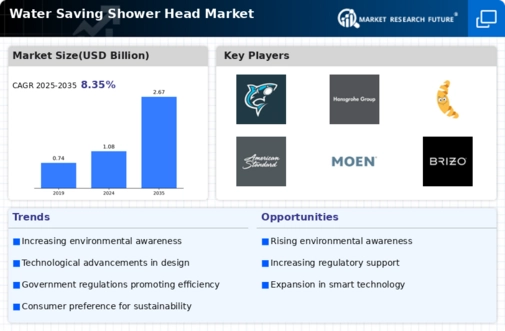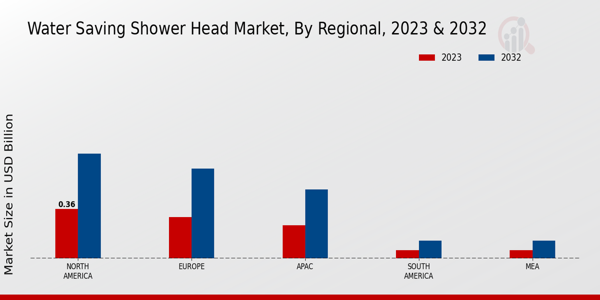Market Growth Projections
The Global Water Saving Shower Head Market Industry is poised for substantial growth, with projections indicating a market value of 1.08 USD Billion in 2024 and an anticipated increase to 2.67 USD Billion by 2035. This growth trajectory reflects a compound annual growth rate (CAGR) of 8.58% from 2025 to 2035. Such figures underscore the increasing consumer demand for water-efficient products, driven by environmental awareness, government regulations, and technological advancements. The market's expansion is likely to attract new entrants and foster innovation, ultimately benefiting consumers and the environment alike.
Technological Advancements
Technological advancements are significantly influencing the Global Water Saving Shower Head Market Industry. Innovations in design and engineering have led to the development of shower heads that maintain water pressure while reducing flow rates. For instance, products featuring aeration technology mix air with water, providing a satisfying shower experience while conserving water. These advancements not only enhance user satisfaction but also contribute to the overall growth of the industry. As consumers increasingly seek high-performance products that align with their sustainability goals, the market is expected to grow at a CAGR of 8.58% from 2025 to 2035, indicating a robust future for water-saving technologies.
Rising Environmental Awareness
The Global Water Saving Shower Head Market Industry is experiencing growth driven by increasing environmental awareness among consumers. As individuals become more conscious of their water usage and its impact on the environment, the demand for water-efficient products rises. This trend is evident in various regions, where governments promote water conservation initiatives. For instance, educational campaigns highlight the benefits of using water-saving fixtures, which can reduce water consumption by up to 40 percent. Such initiatives not only encourage consumers to adopt water-saving shower heads but also align with global sustainability goals, contributing to the industry's expansion.
Urbanization and Population Growth
Urbanization and population growth are key drivers of the Global Water Saving Shower Head Market Industry. As cities expand and populations increase, the demand for water resources intensifies. This situation necessitates the adoption of water-efficient technologies to mitigate the strain on water supplies. In urban areas, where water scarcity is becoming a pressing issue, consumers are more likely to invest in water-saving shower heads. The industry's growth is further supported by initiatives aimed at promoting sustainable living in densely populated regions. By 2035, the market is projected to reach 2.67 USD Billion, reflecting the urgent need for water conservation solutions in urban settings.
Government Regulations and Incentives
Government regulations and incentives play a crucial role in shaping the Global Water Saving Shower Head Market Industry. Many countries are implementing stringent water conservation policies, which often include mandates for water-efficient fixtures in residential and commercial buildings. For example, some regions offer tax rebates or subsidies for consumers who purchase water-saving devices. These regulations not only promote the adoption of water-saving shower heads but also create a favorable market environment. As a result, the industry is projected to reach a value of 1.08 USD Billion in 2024, reflecting the positive impact of such governmental measures on consumer behavior.
Consumer Preference for Sustainable Products
Consumer preference for sustainable products is a driving force in the Global Water Saving Shower Head Market Industry. As awareness of climate change and resource depletion grows, more consumers are prioritizing eco-friendly products in their purchasing decisions. This shift in consumer behavior is evident in the increasing sales of water-saving shower heads, which not only reduce water consumption but also lower utility bills. Brands that emphasize sustainability in their marketing strategies are likely to capture a larger share of the market. This trend suggests a long-term commitment to water conservation, further propelling the industry's growth in the coming years.
















